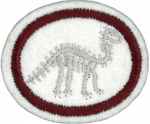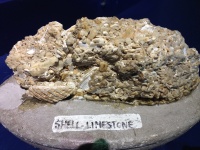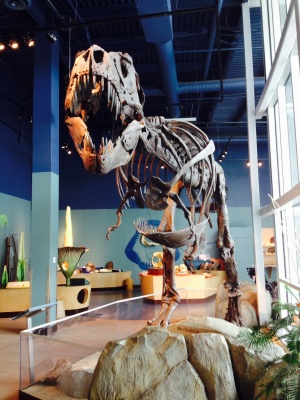Difference between revisions of "AY Honors/Fossils/Answer Key/es"
(Created page with "{{clear}}") |
(Created page with "{{clear}}") |
||
| Line 32: | Line 32: | ||
{{clear}} | {{clear}} | ||
| − | + | {{clear}} | |
Wave washed sea cliffs and foreshore exposures are often good places to search for fossils, but always be aware of the state of the tides in the area. Never take chances by climbing high cliffs of crumbling rock or clay (many have died attempting it). | Wave washed sea cliffs and foreshore exposures are often good places to search for fossils, but always be aware of the state of the tides in the area. Never take chances by climbing high cliffs of crumbling rock or clay (many have died attempting it). | ||
Revision as of 16:34, 25 February 2021
| Fósiles (Asociación General) | ||
|---|---|---|
| Asociación General
|
Destreza: 2 Año de introducción: 1944 |
|
Requisitos
|
La especialidad de Fósiles es un componente de la Maestría Conservación. |
| Conexión Logros para la Investidura: Esta especialidad está relacionada con los requisitos de Logros para la Investidura para EXPLORADOR Estudio de la naturaleza que requiere estudiar artículos que complementan esta especialidad. Esta especialidad es una elección popular para la especialidad de la categoría de Estudio de la naturaleza de nivel de destreza 2 o 3 requerido para los EXPLORADORES DE CAMPO Y BOSQUE. |
1
Wave washed sea cliffs and foreshore exposures are often good places to search for fossils, but always be aware of the state of the tides in the area. Never take chances by climbing high cliffs of crumbling rock or clay (many have died attempting it).
Exposures of softer rocks, such as clays and sands, can be good collecting spots. However inland sections tend to degrade rapidly, becoming overgrown, and are lost forever.
Collecting Ethics
To collect fossils, there are various legal realities that must be observed. Permission should be sought before collection begins on private land.
Hammering the rocks in national parks and other areas of natural beauty is often discouraged and in most cases is illegal.
Equipment
It is important to have the right kind of field equipment when looking for fossils, and safety should always be an important concern.
A hard hat is essential protection from loose stones that may be dislodged from cliffs above, but will not protect the wearer from larger falling rocks. Hard hats are normally a requirement in operational quarries.
Safety goggles and protective gloves are also essential, as rocks can be sharp and dangerous; safety goggles will protect eyes from chips produced while hammering, and gloves protect the hands.
A collector need dress appropriately for collecting trips, taking into account the climate and terrain of the area. Sturdy footwear, such as walking or hiking boots with steel toes, are recommended. A hammer, chisel and wrapping materials are the basic equipment required for fossil collecting, along with a stout rucksack or canvas bag for carrying equipment and fossil finds. The steel of many ordinary hammers is too soft for use on most type of rock. The steel may splinter, and the flying fragments cause injury to the person using the hammer, or others in the vicinity. The hammer should always strike away from the body. The head of a geological hammer or rock pick is made from specially hardened steel designed for use on rocks. The head is either firmly attached to a wooden shaft, or the hammer have the head and the shaft formed from one piece of steel. The head may have any combination of a square face, a tapered point, or a straight chisel edge. The point of such picks are not meant for striking rock directly, but for tapping rock (such as shale) open along planes and for prying: the hammer end is used for striking.
A convenient weight for a general purpose geological hammer or rock pick is around 1 kg (2 to 3 pounds). For breaking very hard rocks one may need a hammer of between 3 and 6.5 kg (7 and 14 pounds) in weight, with a correspondingly longer and thicker shaft. A hammer that is too heavy is tiring to use and results in unsafe work.
2
2a
2b
2c
2d
2e
2f
2g
2h
2i
2j
2k
2l
2m
2n
2o
| Phanerozoic eon | ||
|---|---|---|
| Paleozoic era | Mesozoic era | Cenozoic era |
2p
2q
2r
2s
2t
2u
3
Most museums of natural history will have a fossil collection, and even small museums are likely to have a few. If you do not know of such a museum in your area, the Internet is your friend. Try searching for "fossil," "museum," and the name of your locality. If you are still unsure, get a list of local museums and call them. They will be happy to tell you if they have fossils on display, and if they do not, they may be able to direct you to a museum that does. Also not all museums are called a museum. The T Rex and some other fossils shown here were photographed at Science World in Vancouver. After the visit, have your Pathfinders either write their reports or present one orally. This would be a great topic for worship during your club's opening exercises, or during a campout.
4
Removal of delicate specimens
For extracting fossils from harder rocks, a sturdy mallet and cold steel chisels may also be required. Usually one needs a range of chisels in size from small ones with a sharp edge of about 1 cm (quarter of an inch), to much larger and heavier chisels. A broad-bladed chisel is often very useful for splitting rocks along their bedding plane.
Different types of rocks will break differently and a beginner should put in a little practice, getting the feel for a particular type of rock before he or she starts hammering out fossils. It is all too easy to ruin a specimen with one ill-placed blow of a hammer.
Extracting a specimen that is embedded in solid rock may prove to be a long and difficult process. Before attempting to extract a specimen, the collector should make sure that it is feasible to remove it without destroying or damaging it. Leaving sufficient rock beneath the specimen to protect it from fracturing; excess matrix can be trimmed at a later time.
For soft sediments and unconsolidated deposits, such as sands, silts and clays, a spade and a flat-bladed trowel or stout bladed knife may be the most useful tools for clearing the area around a fossil. Brushes are also useful for removing loose sediment from around fossils.
A sieve is used to separate fossils from sands and gravels. A smaller mesh is required in order to avoid losing small fossils. One practical difficulty with using sieves in the field is that they easily become clogged, especially when the material sieved has a high moisture content. However, under dry weather conditions the more durable fossils, such as teeth and bones, can be quickly and easily sieved out of loose sands. Shaking the sieve is always liable to damage or destroy fragile fossils.
If there is water available, such as on a beach or next to a stream, the material containing the fossils can be sieved wet and the matrix gradually washed away. Wet sieving is a technique that is frequently used for the collection of small mammalian fossils, and by using this technique even the smallest specimens may be recovered.
Removing gigantic fossils
Occasionally, large fragile specimens may need to be surrounded and supported using a jacket of plaster before their removal from the rock: This protects the fossil, protecting it from shattering. If a fossil is to be left in situ, a cast may be produced, using plaster of paris or latex - while not preserving every detail, such a cast is inexpensive, easier to transport, causes less damage to the environment, and leaves the fossil in place for others to enjoy. Subtle fossils which are preserved solely as impressions in sandy layers, such as the Ediacaran fossils, are usually sampled by means of a cast, which shows up detail more clearly than the rock itself.
Valuable fossils
If you find an obviously valuable fossil, you should contact a professional. It is too easy to ruin a fossil by attempting to remove it yourself. Leave the extraction in the hands of an experienced collector. If you find such a fossil on public land, contact the authority responsible for the land. The fossil belongs to them, and they have the right to decide what to do with it. To find a professional, contact a museum or a local university. If they do not have one on staff, they will be able to refer you to one.
5
Evolutionists and creationists both agree that fossils are formed when a creature is quickly buried in sediment. They disagree on how long ago this happened. Evolutionists believe most fossils were made millions of years ago. Creationists believe that nearly all fossils were made during Noah's flood less than 10,000 years ago.
6
- a. Carbón
- b. Petróleo
- c. Fósiles
- d. Caliza
| From Patriarchs and Prophets, pp 107, 108 |
|---|
| Everywhere were strewn the dead bodies of men and beasts. The Lord would not permit these to remain to decompose and pollute the air, therefore He made of the earth a vast burial ground. A violent wind which was caused to blow for the purpose of drying up the waters, moved them with great force, in some instances even carrying away the tops of the mountains and heaping up trees, rocks, and earth above the bodies of the dead.
At this time immense forests were buried. These have since been changed to coal, forming the extensive coal beds that now exist, and also yielding large quantities of oil. The coal and oil frequently ignite and burn beneath the surface of the earth. Thus rocks are heated, limestone is burned, and iron ore melted. |
The Bible itself offers no explicit explanation of coal, petroleum, fossils, or limestone, though it does contain the story of Noah's flood (see Genesis chapters 6-9). In this account, the whole earth is covered by water, and all life, except those in the ark, is lost. The Biblical account of creation rejects the notion of hundred of millions of years of evolution, stating with clarity that God created the world in six days. In Genesis chapter 5, the Bible also provides genealogies of the Patriarchs, including their ages when they had children and when they died. From this, and from other historical records, the Bible sets the age of the Earth at about 6000 years.
References
There are many fine book written from a creationist perspective. Some examples:
- Before the Flood (links to book on Amazon)
- Noah's Flood-Birth of the Ice Age (links to book on Amazon)
- Rocks, Fossils and Dinosaurs (available as free digital book)
- Creation Geology: A Study Guide to Fossils, Formations, and the Flood. (links to book Amazon)
- Evidences The Records and The Flood DVD distributed by Adventist Book Centers.
- Categoría: Tiene imagen de insignia
- Adventist Youth Honors Answer Book/Honors/es
- Adventist Youth Honors Answer Book/es
- Adventist Youth Honors Answer Book/Skill Level 2/es
- Categoría: Libro de respuestas de especialidades JA/Especialidades introducidas en 1944
- Adventist Youth Honors Answer Book/General Conference/es
- Adventist Youth Honors Answer Book/Unknown/es
- Adventist Youth Honors Answer Book/Stage 0/es
- Adventist Youth Honors Answer Book/Conservation Master Award/es
- Adventist Youth Honors Answer Book/IAConnection/es
- Adventist Youth Honors Answer Book/noindex
- Adventist Youth Honors Answer Book




